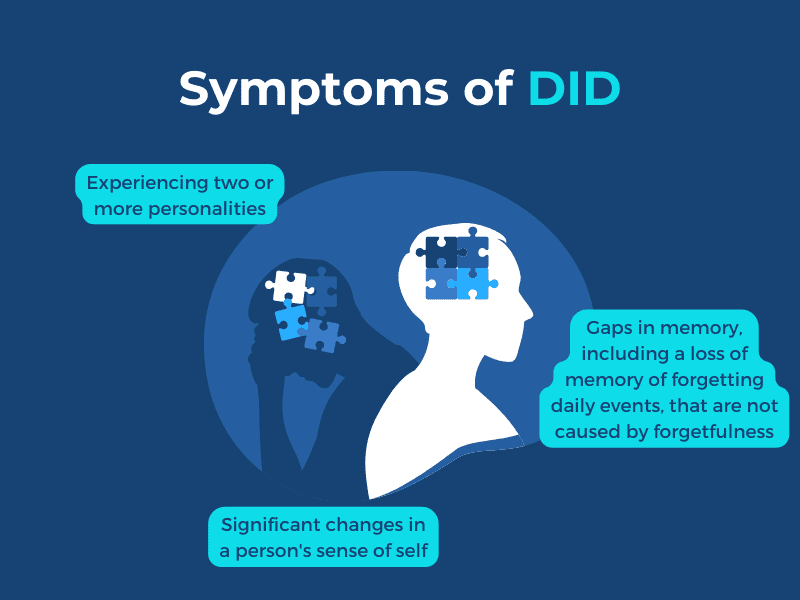Dissociative Identity Disorder Treatment for Teens
Learn more about Dissociative Identity Disorder (DID) treatment for teens.

Dissociative Identity Disorder previously referred to as multiple personality disorder, is characterized by the presence of two or more distinct identities. The National Institute of Health has found that approximately 1% of the population has DID.
A person with DID can have anywhere from two distinct personality states or “alters” to 100. Someone with DID may hear voices in their head that are trying to take control. Their identities may have different names, voices, or characteristics.
When personalities take over, they may use different vocabulary, have different habits, or use different gestures. Teens who have DID may often experience gaps in their memory of daily events, memories, or traumatic events. However, they may experience flashbacks when triggered.
According to the Diagnostic and Statistical Manual of Mental Disorder, the types of dissociative disorders include:
Recognizing the signs of Dissociative Identity Disorder (DID) in teens is crucial for early intervention and support. It’s important to note that the symptoms of DID can sometimes overlap with those of other mental health disorders. Seeking professional help for a comprehensive assessment is vital.
If you have noticed any of these symptoms in yourself or in your loved ones, then don’t hesitate to reach out for support. There is judgment-free treatment available to help you cope with your symptoms.

Anyone can develop DID, but it most commonly develops during childhood trauma.
While DID is generally more commonly diagnosed in adults, studies show that it can manifest during adolescence. According to the American Journal of Psychiatry, approximately 17% of individuals with DID reported the onset of symptoms before the age of 6, and 30% reported the onset before the age of 12.
Teens who have experienced physical abuse, sexual abuse, bullying, drug abuse, parental neglect, or have a family history of DID are at a greater risk of developing the disorder themselves.
It’s crucial to understand that while DID in teenagers is relatively rare, it can and does occur. Recognizing the risk factors and providing support for teens who have experienced trauma is essential for early and effective treatment for DID.


Dissociative Identity Disorder (DID) often gets a Hollywood makeover, with movies like Split and shows like Fight Club and the United States of Tara painting a dramatic, and unfortunately inaccurate, picture.
These portrayals tend to exaggerate things, spreading myths about quick personality switches, inherent violence, and the rarity of DID. It’s not just unhelpful; it adds to the confusion surrounding the disorder.
Lately, social media, especially TikTok, has seen a rise in individuals sharing their experiences with DID. While their stories can break down stereotypes, there’s a flip side. Some worry that these accounts might inadvertently make DID seem glamorous, possibly leading teens to misdiagnose themselves.
Striking a balance between raising awareness and avoiding misinformation is key for everyone to get a more authentic understanding of Dissociative Identity Disorder and to get treatment of DID for those who need it.
Dissociative Identity Disorder (DID) is sometimes thought of as a made-up, attention-seeking act. However, DID is a real and scientifically verified psychological condition that has been recorded since 1584. To suggest that people might fake it not only downplays the struggles of those dealing with DID but also adds to harmful misunderstandings.
DID is not a trendy invention; it’s a legitimate disorder rooted in the experiences of individuals who’ve been through intense childhood trauma.
If you or someone you know is dealing with symptoms of psychosis that feel like they might be linked to DID, it’s crucial to reach out to a professional. They’re the ones equipped to give you the right diagnosis and help you navigate the challenges that come with living with Dissociative Identity Disorder.


People diagnosed with DID are at a higher risk of:
Treatment is always unique to the individual to fit their specific needs.
Age-specific treatment for teens involves a highlight of family involvement in the treatment process and academic and vocational support.
The Continuum of Care
Access a full range of treatments for mental health and substance use disorders. Whether you need a safe transitional living community, inpatient care, or outpatient therapy, we have a program to help.
A doctor may diagnose DID through a review of symptoms and personal history.
Doctors often perform tests at DID treatment centers that can rule out physical conditions that may cause symptoms of dissociative identity disorder, such as memory lapses, mood swings, or a sense of unreality.
DID is often misdiagnosed and requires several assessments to ensure an accurate diagnosis. It is also possible for one “alter” to have an illness or disorder that the others don’t. This makes treatments of DID particularly complex since they are essentially targeting the conditions of multiple people.
According to Clinical Psychopharmacology and Neuroscience, dissociation and dissociative disorders usually relate to childhood trauma.
Dissociative disorders commonly form in children exposed to long-term physical, emotional, or sexual abuse. Sometimes, DID may not stem from abuse but from living in a highly stressful or unpredictable environment.
Experiencing a natural disaster can also play a role in developing a dissociative disorder.

Treatment plans often involve some form of psychotherapy, along with medications to help alleviate some of the symptoms associated with DID.
Psychotherapy, however, is the main form of treatment for DID. Psychotherapy treatment for DID focuses on learning how to cope with traumatic experiences and how to join together a person’s identity.
With psychotherapy, a therapist will try to meet as many alters as possible to understand their roles better. The therapist will try to form relationships with each alter, specifically ones responsible for destructive behaviors, so they can learn how to fix them.
Another important part of treatment for dissociative identity disorder is identifying difficult and traumatic memories so they can understand how they all function as one.
Other low-stress therapies that may help connect the mind can include art therapy, wilderness therapy, or movement therapy.
Medications, like antidepressants, are sometimes used to manage symptoms associated with DID.
There is no cure for dissociative identity disorders.
However, treatments like psychotherapy, also known as talk therapy, can help people manage their symptoms.
Someone with DID may have difficulty trusting others, making it difficult to open up in therapy.
DID is a complex condition, making treatment complex as well.
It is also important to receive treatment from someone experienced with DID. Therapists will try to communicate with alters, understand each of them, and help in the places that need it.
Therapy Treatments
We deliver evidence-based therapy treatment for teens in a number of areas. We’re available 24/7 to answer any questions.
Dialectical-behavior therapy (DBT) is another form of psychotherapy that was originally designed for individuals who were chronically suicidal or diagnosed with borderline personality disorder.
However, today, DBT is used as an effective approach for treating various mental illnesses, including DID.
DBT focuses on four main skills: mindfulness, interpersonal effectiveness, distress tolerance, and emotion regulation.
DBT is specifically effective for teens and young adults because it targets specific thoughts and feelings that lead young people to make destructive choices.
Switching refers to the process of changing from one personality to another.
DID switching can differ based on the person. Each person’s circumstance is unique and may be extremely different than what another person with DID experiences.
DID switching is typically involuntary and can cause a lot of distress. However, some people have more control over their switching than others, and some people may not even notice they’re switching.
A person may also experience symptoms like anxiety or anger when switching, as they may fear the change.
Sometimes family members can tell when their loved ones are switching; other times, they may never know.
Physical signs that may indicate someone is switching can include:

There are a variety of different triggers for DID and switching.
Stress can play a big role in switching. When someone with DID is experiencing large amounts of stress, they can switch to multiple personalities within minutes.
Teens may experience large amounts of stress when it comes to new experiences, school, friends, family, and other personal problems. Struggling with DID as a teenager can be extremely difficult to manage without treatment and therapy.
Memories can also trigger switching, whether they are good or bad. For example, if someone is talking about the past or when they see something that reminds them of strong feelings, it can trigger an episode.
Certain senses like smells, sounds, or tastes can bring up past experiences that trigger an episode.
Other triggers can include substance use, changing seasons, or certain events.
Check out our selection of frequently asked questions — or call us to ask us today.
Childhood trauma splitting is a psychological coping mechanism for difficult or overwhelming experiences.
When someone experiences stressful events in their childhood like violence, verbal abuse, or neglect, they may internalize their feelings.
This causes them to withdraw both internally and externally.
When childhood trauma splitting is carried into adulthood, a person may constantly struggle with internal conflict. One part may still feel like a child, while the other part thinks and acts like an adult.
In childhood trauma splitting, a person shuts out things that remind them of their trauma as a way to get through every day.
It can lead to symptoms such as memory loss, emotional numbness, dissociation, isolation, and shame.
Because teenagers are experiencing major brain development throughout their mid-twenties, they are more vulnerable to developing mental illnesses.
While dissociation identity disorder is rare among teens, many adolescents will likely experience a type of dissociation episode as they approach adulthood. Many mental health issues can cause different types of dissociation, so it is less rare for them to be experienced by teens and young adults.
Dissociation refers to a disconnect from yourself and the world around you. Derealization refers to a detachment from your surroundings or environment.
Children and teens who experience trauma can also be vulnerable to dissociation and derealization. Derealization most commonly occurs for the first time in teenagers, starting at around 16 years old.
Alters switch, or come out, when there is a trigger, whether it is positive or negative.
Switching is typically involuntary, and some people have more control over it than others.
Everyone’s system is unique and different, and some may not have control of when different alters come out.
Internal signs that may indicate you are switching to a new alter can include:
One of the most helpful things to do is to go to therapy.
You can also use grounding techniques, including slow breathing, walking barefoot, listening to sounds, feeling something that brings comfort, or smelling something with a strong scent.
It may also help to write down your experiences. Keeping a journal can also help you identify your triggers so you can learn how to manage or cope with them.
Healthy activities like exercising may also help to feel present in your body.
Having a strong support network that includes clinicians, family members, and friends can help when you need someone to talk to and is an important part of treating DID.
It is difficult to tell if someone is faking DID.
People with DID have unique situations, so it would be hard to tell whether someone is faking DID or not.
Rather than trying to determine whether someone is struggling with DID or not, the best thing to do is reach out for professional help to receive a proper diagnosis.
Splitting is different for each individual.
It can be uncomfortable and distressing for some people, while it may not be as significant for others.
Each person has unique experiences when it comes to splitting, but they often have no control over it.
Testing for DID may include physical exams, psychiatric exams, and reviewing the diagnostic criteria in the DSM-5, which is published by the American Psychiatric Association.
According to StatPearls, dissociative identity disorder is a rare disorder diagnosed in approximately 1.5% of the global population.
DID is also commonly misdiagnosed for other mental illnesses like schizophrenia or bipolar disorder.


Not sure where to begin?